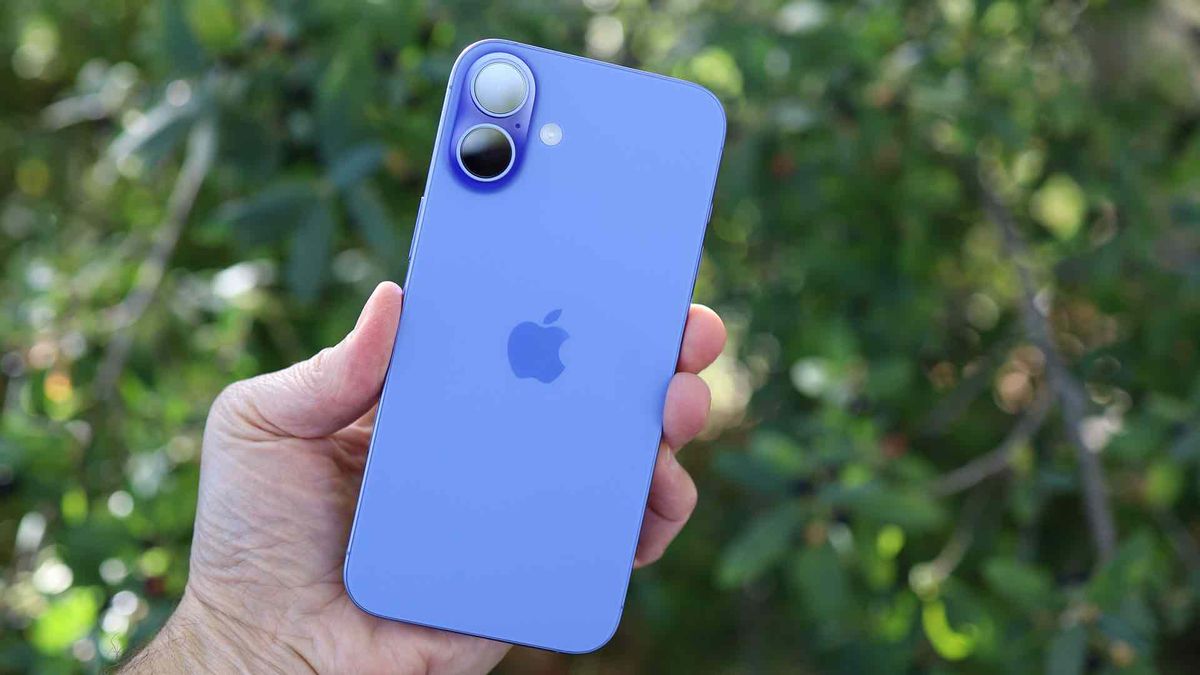The $299.99 Tribit StormBox Blast 2 builds on the success of its predecessor by adding even more bass, support for two microphones to power your backyard karaoke, and customizable party lights, all packed in a waterproof boombox. We like its big sound and incredible battery life, but it is weighty at nearly 20 pounds, and Tribit has raised the price by $100 compared with the original. For less money, the $249.99 Anker Soundcore Boom Plus 2 weighs half as much and still produces big sound with flashing lights in a watertight design, so it remains our Editors’ Choice winner for outdoor speakers.
Design: Built Like the Workhorse It Is
The StormBox Blast 2 is a heavy hitter, and it’s built like one. It’s a substantial, chunky boombox constructed out of sturdy, textured plastic. The sizable bass radiators at each end feel robust despite being made of rubber. The unit has an IP67 rating, meaning it’s dust and waterproof, so you can take it to the beach and not worry about sand, splashes, or even a dip in the water. The speaker measures 10.5 by 19.0 by 7.5 inches (HWD). It’s not terribly tall, but it’s quite wide. A large handle arches over its top, making it easier to tote its 19.1-pound weight.
For comparison, the original StormBox Blast ($199.99) measures 8.9 by 16.0 by 6.4 inches and weighs 11.6 pounds, while the Boom Plus 2 measures 9.0 by 17.4 by 5.9 inches and weighs 8.4 pounds.
An oblong, rubberized base holds the unit steady. Although the base is intended to keep it level, the speaker’s shape allows it to tilt backward at an upward-facing angle, which is useful when setting it up on a floor.
There’s a selection of physical controls on the top that includes a power button with four battery-level indicator lights next to it, as well as Bluetooth pairing, volume, and play/pause controls. There are also buttons to quickly toggle the lighting effects and the XBass mode on or off and a button to set the speaker into Stereo or Party Mode pairing, which lets it link up with additional Tribit speakers. In Stereo mode, each speaker becomes either a left or right channel, while in Party Mode, two or more speakers simply sync up their audio, with each playing the full range of sound.
(Credit: Mark Knapp)
Tribit packs a lot into the speaker. It claims a total output of 200 watts when using AC power and 180 watts using battery power. The speaker has an 80-watt racetrack subwoofer front and center, flanked by two 45-watt midrange drivers. Two 15-watt tweeters sit above the midrange drivers. This gives the speaker a 2.1-channel setup. The large passive radiators that cap its ends boost the bass response. The Blast 2 produces a frequency response of 40Hz to 20kHz. It supports Bluetooth 5.4 but only the basic SBC codec. At this price, we’d have liked to see Tribit add a wider range of codecs like AAC at a minimum.
The five active drivers are tucked behind a perforated plastic grille and have some eye-catching LEDs. A thin bar stretches across the grille between the two midrange drivers. RGB lights shine onto the two side drivers and the subwoofer. Two vertical light bars at either end of the grille house more LEDs. Together, the lights form three separate zones, each of which can be run separately. The Blast 2 puts on a vivid light show, offering well-synced visuals, but it’s only visible from the front; there are no lights on the sides or rear.
There’s another grille on the back of the speaker, but this one is purely for aesthetic reasons. I appreciate the design continuity, which contributes to the high-end look. A beefy rubber cover protects the speaker’s numerous ports and is centered within the rear grille.
The speaker lacks a built-in microphone, so you can’t use it to take calls from a connected device or activate a smart assistant, but it includes two quarter-inch jacks for plugging in microphones (not supplied). If you need a miniature public address speaker or care to sing karaoke, you’ve got the option. Each jack has its own volume dial, as well as a master reverb dial. I found the reverb effect’s echo to be too strong, even at the lowest setting, so I left it turned down.
(Credit: Mark Knapp)
There’s a 3.5mm input jack for wired audio connections, a USB-A port that lets you use the speaker’s 79.92Wh battery to charge external devices, and a USB-C port you can use to recharge the speaker. You cannot use the USB-C port to charge other devices. Moreover, the USB-C port is not ideal for charging the speaker itself, which will require 12 hours this way.
The quickest way to recharge the speaker is via the figure-eight connector, which lets you plug into AC outlets with the supplied power cable and recharge in just 5 hours. Once the speaker is fully charged, it can run for up to 30 hours with lighting disabled, XBass off, and volume at 50%. Your battery life will vary depending on the use of the lights and how loud you play it. The Anker Soundcore Boom Plus 2 runs for up to 20 hours under similar settings.
Tribit App: Tailor the Sound and Light to Your Liking
The Tribit app (available for Android and iOS) enables additional speaker controls. You don’t need an account to use the app, and it’s simple to navigate. The app provides a quick menu for volume and playback control and a more granular look at battery level than the four-bar display on the top of the device.
A second tab provides access to the lighting controls where you have the option to set up three different presets. The speaker splits its lighting into three distinct zones, which you can set to cycle through a selection of colors or stick with one shade. You can also link each zone to react to bass, treble, or both or simply remain lit. With a little tinkering it’s possible to get a dynamic light show from the speaker, and it does an outstanding job of syncing the lights to your music.
(Credit: Tribit/PCMag)
The app provides a handful of preset EQ settings and the option to create your own with a 10-band equalizer. While the speaker’s XBass button toggles the feature on or off by default, you can use the app to change which EQ profiles it toggles between.
Sound: Seriously Booming
By default, the XBass Boost feature is on—and it is simply overpowering. Even when listening to music at low volume levels, the bass is so ramped up that it’s downright thunderous. Given that the speaker’s bass response is still strong with XBass off, I conducted my evaluation with XBass Boost disabled.
The Knife’s “Silent Shout” roars out of the StormBox Blast 2. The bass triplets pump hard and the even deeper sub-bass quarter notes that carry the track pound with an impressive weight. Despite the strong bass, the speaker is well-balanced in this setting. The heavy low-end does not overpower the synth lines, which sing out brightly in the middle frequencies. Even the digital egg shaker and cymbals in the upper registers are clear. The harmonized vocals are somewhat suppressed, especially the lower harmonies. They don’t sound as clear as they should, even for vocals that are intended to be somewhat ghostly. The speaker struggles a bit with subtlety. This may also be in part due to the limited separation between the speaker’s midrange drivers and tweeters.
Meanwhile, the vocals aren’t overrun in Bill Callahan’s “Drover.” They’re deep and central in the track, and the StormBox presents them loud and clear and backed neatly by the acoustic guitar. The bass is beautifully rendered and doesn’t overwhelm the other elements. The limited stereo separation does tame some of the track’s drama from the panned fiddle and electric guitar. With the speaker’s amped-up bass, it gives a bit too much juice to the thumping floor tom, which hits so frequently that it becomes more of an assault than an accompaniment.
(Credit: Mark Knapp)
The speaker’s bass presence is impressive, thanks to its subwoofer and radiators, but it still comes up a little short on depth. Kendrick Lamar’s “Loyalty.” remains a challenge for it. When the sub-bass line comes in shortly after the 30-second mark, the speaker manages all but one note. It’s admirable, but the deepest sub-bass note in the track is just outside of the Blast 2’s range, whether XBass is on or not. Most speakers suffer the inverse issue: many can only hit one note of the progression and miss the rest. The Blast 2 delivers all of that bass while still presenting Lamar and Rihanna’s vocals clearly alongside a crisp drum rhythm.
That minor shortcoming in sub-bass holds back the tympani and bass notes slightly in John Adams’ The Gospel According to The Other Mary. On this track, the limited stereo separation doesn’t build much of a soundstage for the many instruments and voices to stand apart, which creates a rather bunched-in sound, though passages with fewer instruments can sound quite good.
The speaker really comes into its own when it’s cranked up loud. While there’s plenty of bass, no matter the volume, when the volume is below 50%, the tweeters are surprisingly faint. At higher volumes, the speakers work together in better balance. The Blast 2 can deliver truly enormous sound.
Verdict: A Big and Brash Blast
The Tribit StormBox Blast 2 is a force to be reckoned with. It delivers thunderous audio, can deliver an attractive light show to match its party energy, and supports up to two microphones for use as a karaoke speaker. By combining a dedicated subwoofer with dual midrange drivers and tweeters, it manages to dig deep into sub-bass territory—where most portable speakers usually struggle—without overpowering the middle and higher frequencies. The Blast 2 is a powerful, portable, party-ready speaker that’ll liven up any get-together. That said, the Anker Soundcore Boom 2 remains our Editors’ Choice winner thanks to its more portable design, highly adjustable sound, equally compelling light show, and lower price.
Pros
View
More
The Bottom Line
The Tribit StormBox Blast 2 is a potent Bluetooth party speaker with five drivers that delivers high-volume audio with a wide frequency response.
Like What You’re Reading?
This newsletter may contain advertising, deals, or affiliate links. Subscribing to a newsletter indicates your consent to our Terms of Use and Privacy Policy. You may unsubscribe from the newsletters at any time.

About Mark Knapp
Contributing Writer













